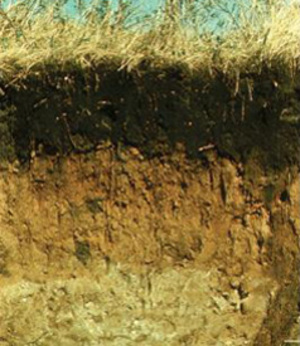 Photo :EPSRC
Photo :EPSRC
In this Canadian prairie soil, a brown
organic layer overlies gravel containing natural calcium-bearing
carbonates, which could aid the fight against global warming.
Three mounds of soil, covered in wild grasses in an abandoned corner
of the quarry. Apparently, nothing could be more ordinary. Unless you
are David Manning, professor of geology at Newcastle University (United
Kingdom), for whom they were the source of a very big surprise. These
tumuli concretize an experiment that the scientist has been conducting
since 2002 in this quarry for road works materials.
There, David Manning tested a mixture of compost and quarry
dust in order to evaluate whether it would make a good ground cover
after the quarry’s closing. In 2007, when he returned to the site, he
observed that crystals of calcium carbonate – i.e., chalk – had formed
in totally unexpected proportions. A subsequent analysis showed that
the carbonates came from the plants and not from the stone.
That observation led the geologist to think that there was
a completely new way of absorbing carbon gas: stimulation of plants’
natural carbon fixation process. We know that plants absorb CO2 through
photosynthesis. But they secrete part of it in the form of organic
acid. Why? "It’s the result of stress," explains David Manning. "When
they lack nourishment, they release an acid that dissolves the
underlying stone and frees nutritive elements, such as phosphorus."
In most soils, that carbon returns to the atmosphere. But
in calcium-rich soil, the acid, which contains carbon, reacts with the
calcium by forming calcium carbonate deposits around the roots.
Isotopic analyses have shown that this carbon-trapping is significant:
it could reach 150 kg [330 lbs.] per year per hectare in a field of
wheat.
The carbonates in the soil remain stable for very long
periods and consequently constitute a virtually permanent geological
carbon sink. "They could be used passively, the same way reed beds are
used in lagoons to grab heavy metals out of polluted water," David
Manning asserts.
By enriching soils with calcium, we could, in fact,
stimulate this process. Such calcium could come from volcanic rock
quarries, which produce great quantities of it through the dust they
generate. Demolition sites could also constitute another source of
calcium, as could steelmaking.
A Computer Model
According to David Manning, the 2.5 million hectares of
wheat cultivated in England could, in this way, absorb 14 million tons
of CO2, or close to 3 percent of the country’s emissions. But carbon
could also be sunk on restored quarry or construction sites planted
with vegetation.
The validity of the method still has to be verified by a
network of laboratories. The researchers will make up artificial soils,
highly enriched with calcium, and grow wheat, lupin and sedum in order
to measure the amount of carbon fixed. That will allow a computer model
to be developed that will define the speed and the quantities of
calcium carbonate formation in soils with different compositions. "This
method of fighting climate change could be almost painless," David
Manning believes.
This experimentation is highly illustrative of the new
interest soil arouses as climatologists discover it is a major actor in
the carbon cycle. The planet’s soils contain more carbon gas that the
atmosphere and terrestrial vegetation: 1,500 billion tons in organic
soils and 720 billion tons in carbonated soils, versus 500 billion tons
in all vegetation.

